2 Apr 2014
The SCI Board of Trustees has decided to improve its links with Groups by appointing a Trustee to act as a link to each Group. We are therefore delighted to welcome Prof Jenny Mordue from the University of Aberdeen as our link Trustee. Jenny will be joining our Committee meeting to discuss how best she can help the Group.
This month sees the closing date for this year's David Miller Travel Bursary Award on 14 April. We already have a good number of applications submitted but there is always room for more. Judging will begin immediately after the closing date and we hope to announce this year's winners at the beginning of May.
Also on 14 April we will be joining the Professional Horticulture Group South-West for a visit to Forde Abbey Nursery and Gardens. The nursery concentrates on producing a range of herbaceous perennials and grasses while the 30 acre garden was started in the 18th century by a Monsieur Beaumont, who was a pupil of the French garden designer Le Nôtre, best known for the gardens of Versailles.
On 15 May we will be joining the BioResources Group for an event entitled Breeding Plants for the Future. An excellent panel of speakers has been assembled for the meeting, which will look at the numerous innovations that are dramatically changing plant breeding and the potential performance of crop varieties.
Editor
The versatile tomato
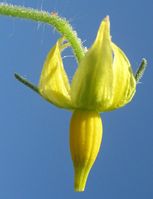
The cultivated tomato has long been classified as Lycopersicon esculentum. However the relationship between the genus Lycopersicon and its close relative the genus Solanum remains confused so the tomato is also known as Solanum lycopersicum. However, most members of the genus Lycopersicon can still be easily recognised from the rest of the Solanum genus by the flowers.
The majority of Solanum species, in common with the majority of flowering plants, have separated anthers. In contrast, tomato anthers have bands of hairs down their sides which interlock and hold the five anthers together in a cone (picture right). This cone naturally funnels all the pollen to the narrow opening through which the style protrudes. In the wild tomato species the style is long and holds the stigma well clear of this opening allowing cross pollination to occur. This is effected by bumble bees.
In the cultivated tomato the style is shorter so that the stigma sits in the opening, encouraging self-pollination. Tomatoes grown outdoors receive sufficient vibration to shake the pollen onto the stigma but in the stiller air of the glasshouse it has been traditional to 'vibrate' the flowers, initially by hand and then with mechanical 'buzzers'. More recently the natural method of bumble bees has been adopted spawning a new industry to rear large quantities of bees to introduce into the glasshouses.
Most wild tomato species grow at high altitude in the western valleys of the Peruvian Andes. Here their natural spread is inhibited by mountain barriers and the native people were discouraged by their poisonous green fruit. However one species, Solanum pimpinellifolium, grew at lower levels and had red edible fruit. Despite this, there is no evidence that the natives of Peru or Ecuador ate them. Instead they helped the species spread possibly as a weed along the numerous irrigation channels they created. Spread the species did through Central America to Mexico, where the Aztecs seem to have recognised its potential and selected many of the varied forms that we know today.
Despite this variety the UK until recently only grew and ate one type with red-fleshed near spherical fruits of approximately 45-50mm diameter. Although this type still predominates, we now eat a much more diverse range of small-fruited and oval-fruited types.
The larger 'beefsteak' varieties common in many other countries have never caught on, possibly because their large deformed flowers are difficult to pollinate in our northern climate. They are, however, an important crop in many parts of the world and form the basis of the tomato paste industry. This industry wants fleshy fruits with few seeds, not the juicy fruits with many seeds that we tend to eat.
While our juicy fruit are still picked by hand, the processing industry has moved to mechanical harvesting. Here the soft skin of the normal tomato becomes a disadvantage, as too many fruit are damaged by the harvesting machine. Modern processing varieties are thus not only large fleshy-fruited with virtually no seeds but they are also thick-skinned.
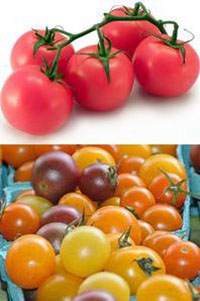
Contrary to the story sometimes put around, there is no connection between colour and flavour. Tomato flavour is primarily a balance between sugars and acids and much breeding and cultural work has been done to maximise these flavour components. Sugars however need sunlight to form, and no amount of breeding and culture can compensate for poor light. The more subtle flavours are down to a complex of flavenoids which have so far been elusive to understand and difficult to breed.
Modern breeding techniques may help solve this problem. Genetic modification has been used in the tomato since the 1980s and the slow ripening Flavr Savr tomato was the first crop to certified for commercial use in 1994. Since then a number of 'healthy' options have been created, the latest being the John Innes Institute's purple tomatoes bred to have a high anthocyanin content, which are currently being grown in Canada.
Despite the great variety of tomatoes available, and these advances in tomato genetics, the majority of us in the UK will continue to eat the traditional round red juicy varieties, while relying unconsciously on the fleshy 'beefsteak' types to supply our ketchup and tomato paste.
Plant of the Month
Sequoia sempervirens, coast redwood, Taxodiaceae
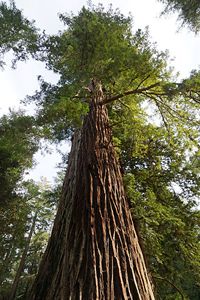
Sequoia sempervirens is the only extant species in this genus, purportedly named for a gentleman called George Gist, son of a German-American merchant and an American Indian girl. He invented the Cherokee alphabet, and was known as Sequoiah, a nickname often given to mixed-race Cherokee children. This plant was first described by botanists in 1824, from a sample collected by the Vancouver expedition in 1794, and named Taxodium sempervirens (evergreen) to distinguish it from all other species of Taxodium, which are deciduous. However, the name was revised in 1847, by the Austrian botanist Stephen Endlicher to the current genus name of Sequoia.
These trees can grow to over 100m tall, with a girth at the base of over 25m around. They often grown in association with other conifers, such as Sitka spruce (Picea sitchensis) and Douglas fir (Pseudotsuga menziesii). There is also a surprisingly rich under-storey of herbaceous and shrubby plants, as the narrow canopies allow enough light to penetrate to the floor to support this diversity.
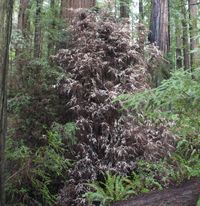
A more common tourist attraction, though, would have to be the trees that can be driven through, or have been made into houses and rooms. There is even a 'travel-log' - a kind of caravan that has been constructed from the trunk of one of these giant trees. But what better thing to do, than to hike through the old growth forests, marvelling at the size and splendour all around you.
Further reading: Coast redwood - a natural and cultural history. Cachuma Press ISBN 0-9628505-5-1.
Alison Foster
Oxford Botanic Garden
Horticulture Industry News
For the very latest horticultural news follow us on Facebook,
Twitter, or
LinkedIn
Future heat waves pose threat to global food supply…
A new study estimates for the first time the global effects of extreme temperatures and elevated levels of carbon dioxide (CO2 ) on the production of maize, wheat and soybean. This shows that the inclusion of the effects of heat waves, which have not been accounted for in previous modelling calculations, could double the losses.
Instances of extreme temperatures, brought about by a large increase in global mean temperature, can be detrimental to crops at any stage of their development, but in particular around anthesis. At this stage, extreme temperatures can lead to reduced pollen sterility and reduced seed set, greatly reducing the crop yield. The impacts on wheat and soybean are likely to be less profound, primarily because of the fertilisation effects that elevated levels of CO2 can have on these crops. More and More.
…. but more olives
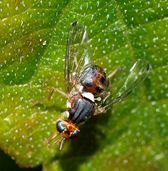
While the region's olive crop will improve overall, some areas will see profits drop substantially. North Africa estimated profits will rise more than 41%, but in the Middle East, along the eastern portions of the Mediterranean, profits will decline an average of 7.2%. How increased warmth affects the olive fruit fly will have the biggest effect on profits, the team notes. Because the olive tree withstands heat better than its major pest does, some areas now infested with the olive fruit fly will become unsuitable for the insect in coming years. More
Salads supplier Vitacress to streamline UK operations
Leaf salads supplier Vitacress, a wholly-owned subsidiary of Portuguese firm RAR Group, plans to merge three of its units; Vitacress Salads, VHB Herbs and Wight Salads. The new entity, which will be named as Vitacress, will be headquartered at the company's site in Chichester, South-East England and headed by Toby Brinsmead.
The company's existing head office in Eastleigh will be shut down. The proposed changes will not affect the company's growing, packing and distribution centres. The changes will provide the company with a simpler structure, closer to its customers, with more ability to invest in the future. Vitacress offers prepared and packaged salads with operations in the UK, Spain and Portugal. It has a workforce of around 2,000 in the UK. More
Studying photosynthesis from outer space
Satellite technology can now be used to measure plant fluorescence produced when sunlight excites the photosynthetic pigment chlorophyll. The method offers a direct measurement of activity occurring as the satellite passes overhead. A research team reports on observations of fluorescence from large areas of crops in the Midwestern Corn Belt and shows that the previous model-based estimates of photosynthesis are too low.
What's more, these studies provide a new-and-improved tool to evaluate the comparative productivity of the breadbaskets of the world, such as the Indo-Gangetic Plain and Eastern China. The relationship between fluorescence measured from space and gross primary production measured in the Corn Belt also provides a way for researchers to assess in near real-time the production of other, non-agricultural areas of the world, including vast expanses of uncultivated forests and grasslands. More
Paddle protein shapes leaves
Wikipedia lists 65 adjectives that botanists use to describe the shapes of plant leaves. These shapes are controlled by the distribution of a plant hormone auxin, which determines the rate at which plant cells divide and lengthen.
Now scientists have made a discovery about one of the proteins in the auxin signalling network that may prove key to understanding the entire network. They explain that they were able to crystallize a key protein called a transcription factor and work out its structure.
The interaction domain of the protein, they learned, folds into a flat paddle with a positively charged face and a negatively charged face. These faces allow the proteins to snap together like magnets, forming long chains, or oligomers. By varying the length of these chains, plants may fine-tune the response of individual cells to auxin to produce detailed patterns such as the toothed lobes of the cilantro leaf. More
Fyffes and Chiquita merge to create banana leader
The banana is the world's most widely-produced fruit, and has been associated for decades with political intrigue and bitter trade disputes. But it has an increasingly tenuous grip on existence, threatened by diseases such as Black Sigatoka (Mycosphaerella) and a deadly new strain of Panama disease (Fusarium).
Now Dublin-based Fyffes and US based Chiquita have responded to such pressures with an all-share merger that will form a distributor with a workforce of 32,000, almost $5bn in annual revenues and a market value of more than $1bn. Fyffes was once owned by United Fruit, the company that became associated with corruption and regime change in Central America and the Caribbean before emerging after a restructuring as Chiquita. But Fruit Importers of Ireland bought Fyffes in 1986.
Dublin-based Fyffes - which oversaw the first commercial delivery of bananas to London in the 1880s and, like Chiquita, is known for its blue sticky labels - is Europe's number one distributor with a market share of 16%. Chiquita, based in North Carolina, has a strong presence in North America, where it competes with large global rivals Del Monte and Dole. More
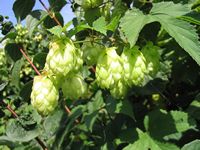
Hop cones discarded in beer brewing have substances that could fight dental diseases. Recently, scientists reported that the part of hops that isn't used for making beer, contains healthful antioxidants, and could be used to battle cavities and gum disease. Now researchers say that they've identified some of the substances that could be responsible for these beneficial effects.
They note that their earlier research found that antioxidant polyphenols, contained in the hop bracts (pictured right) could help fight cavities and gum disease. Extracts from bracts stopped the bacteria responsible for these dental conditions from being able to stick to surfaces and prevented the release of some bacterial toxins. More
A new carotenoid helps root branching
In plants, continuous formation of lateral roots (LRs) facilitates efficient exploration of the soil environment. Roots can maximize developmental capacity in variable environmental conditions through establishment of sites competent to form LRs. This LR pre-pattern is established by a periodic oscillation in gene expression near the root tip.
Researchers have found that disruption of carotenoid biosynthesis results in seedlings with very few LRs. Carotenoids are further required for the output of the LR clock because inhibition of carotenoid synthesis also results in fewer sites competent to form LRs. Genetic analyses and a carotenoid cleavage inhibitor indicate that an apocarotenoid, distinct from abscisic acid or strigolactone, is specifically required for LR formation.
Expression of a key carotenoid biosynthesis gene occurs in a spatially specific pattern along the root's axis, suggesting spatial regulation of carotenoid synthesis. These results indicate that developmental prepatterning of LRs requires an uncharacterized carotenoid-derived molecule. More
Bionic plants: Nanoparticles enhance photosynthesis
Researchers report boosting plants' ability to capture light energy by 30% by embedding carbon nanotubes in the chloroplast. Using another type of carbon nanotube, they also modified plants to detect the gas nitric oxide. Together, these represent the first steps in launching a scientific field the researchers have dubbed 'plant nanobionics.' The researchers then turned to living plants and used a technique called vascular infusion to deliver nanoparticles into Arabidopsis thaliana.
Using this method, the researchers applied a solution of nanoparticles to the underside of the leaf, where it penetrated tiny pores known as stomata, which normally allow carbon dioxide to flow in and oxygen to flow out. In these plants, the nanotubes moved into the chloroplast and boosted photosynthetic electron flow by about 30%. More
Missing link in plant immunity identified
After a 30-year search, scientists have uncovered how an enzyme critical to plants' rapid immune response against microbes is activated. The enzyme, the NAPDH oxidase RBOHD, triggers a rapid generation of signalling molecules derived from oxygen that are believed to be detrimental to microbial growth. The newly-discovered way this enzyme is activated, by a protein (called BIK1) fills a gap in how plants perceive a threat and how signals are activated to trigger an immune response. More
Ash research reveals first genetic clues to fight dieback
Scientists collaborating on ash dieback research, caused by the fungus Chalara fraxinea, can reveal the first genetic clues that could help them identify and breed trees tolerant to the disease. They analysed data from around 180 Danish trees. The susceptibility of these trees to ash dieback has previously been measured.
Some Danish trees are known to withstand the disease and this is the first data showing that activity in some genes seems to be particularly important. One of the most resistant Danish trees is a strain called 'Tree 35'. The researchers made a catalogue of all the genes expressed in this strain during the first flush of growth in young leaves. They then used this as a reference from which to catalogue genetic variation amongst 180 Danish trees that have been scored for disease resistance. More
Global Transition to New Brand to Commence in 2014
Makhteshim Agan Industries (MAI), a world leader in crop protection solutions, has announced that it will transition to a new global brand, ADAMA, beginning this month. To support the initiative, MAI changed its legal entity name to 'ADAMA Agricultural Solutions Ltd.'.
The name ADAMA comes from the Hebrew word for earth or soil and reflects the company's farmer-centric focus and its commitment to advancing agriculture in its markets around the world. Brand implementation will be conducted on a global basis with staggered country-by-country launches. The full transition to the new brand is expected to be completed by the end of 2015.
Events Calendar
Pollinators in Agriculture
1 - 3 Apr, Association of Applied Biologists
Brussels, Belgium
The Genus Lilium
1 - 3 Apr, International Society for Horticultural Science
Zhangzhou, China
Trees, People and the Built Environment
2 - 3 Apr, Chartered Institute of Foresters
Birmingham, UK
Global Berry Congress
7 - 9 Apr, Eurofruit
Amsterdam, The Netherlands
Wild Relatives of Subtropical and Temperate Fruit and Nut Crops
7 - 12 Apr, Wild Relatives of Subtropical and Temperate Fruit and Nut Crops
Baku, Azerbaijan
Investment for business growth - the legal side explained
11 Apr, InCrops
Harpenden, UK
Natural & Organic Products Europe
13 - 14 Apr, Diversified Communication
London, UK
Sulfur Metabolism in Plants
14 Apr, Institut für Forstwissenschaften
Freiburg, Germany
Advances in Cider Technology
16 Apr, Association of Applied Biologists
Pershore, UK
FPJ Live
30 Apr, Fresh Produce Journal
Birmingham, UK
Plant Genomics Conference
12 - 13 May, Global Engage
London, UK
Brassica Conference
15 May, UK Brassica Research Community
Wellesbourne, UK
Loquat Symposium
12 - 15 May, International Society for Horticultural Science
Palermo, Italy
Society of Biology AGM
15 May
London, UK
Plant Chemical Biology
16 May, Agrinet
Jealotts Hill, UK
Risk assessment considerations for RNAi-based GM plants
4 Jun, European Food Safety Authority
Brussels, Belgium
London Produce Show
4 Jun
London, UK
CO2 Assimilation in Plants: Genome to Biome
7 - 8 Jun, Gordon Research Conferences
Waterlooville Valley, USA
World Processing Tomato Congress
8 - 11 Jun, International Society for Horticultural Science
Sirmione, Italy
GreenTech
10 - 12 Jun, Amsterdam RAI
Amsterdam, The Netherlands
Postharvest Unlimited
10 - 13 Jun, International Society for Horticultural Science
Cyprus
Breeding Plants to Cope with Future Climate Change
16 - 18 Jun, Association of Applied Biologists
Leeds, UK
Agronomic Decision Making in an Uncertain Climate
19 Jun, Association of Applied Biologists
Leeds, UK
Plant Biology Europe
22 - 26 Jun, EPSO
Dublin, Ireland
If you would like to advertise a forthcoming event please contact. ester.monfort@soci.org
Horticulture Group Contact Details
For submitting ideas or to volunteer to be part of a committee or a group, please contact:
Chairman - Peter Grimbly
Meetings Secretary - Alison Foster
Minutes Secretary - Margaret Waddy
Newsletter co-ordinator - Sue Grimbly scihortigroup@btinternet.com
Group Contact - Ester Monfort Martinez, E: ester.monfort@soci.org T: +44 (0)20 7598 1584
